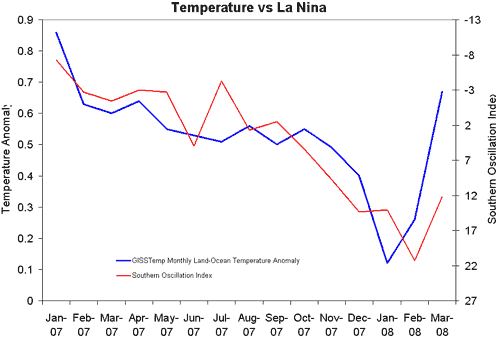La Nina watch: March update
Posted on 9 April 2008 by John Cook
I confess to checking the NASA website like a true data geek the last few days, waiting for them to update the Land Ocean Temperature Index with March's figures. We saw last month how the La Nina cooling experienced through 2007 may have already started to reverse when February showed distinct warming compared to January. But what would March tell us? I must admit, even I was surprised.

Figure 1: Land Ocean monthly Temperature Anomaly (blue line - NASA GISS) compared with Southern Oscillation Index (red line - Australian Bureau of Meteorology). Note - SOI axis is reversed as positive SOI corresponds to La Nina conditions.
The temperature jump over the last two months is surprisingly high. John Cross predicted 0.45°C for February (which I thought was an overestimation). March's 0.67°C blows that out of the water. What is the significance? Probably the danger of reading too much significance in short term temperature change. Daily Tech proclaimed 2007 wiped out a century of warming. By that logic, you could say the last two months reinstated 75 years worth of warming.
At best, we can surmise the La Nina cooling may have subsided. The Southern Oscillation Index, a measure of La Nina activity, shows a reversal but only over the last month. We'll have to watch and see how the next few months progress. Anyone care to go on record with an April prediction? Crossy?
UPDATE 10 Apr 2008: Atmoz gives an insightful analysis of global temperature maps and finds a significant contributor to March's temperature spike is a large temperature anomaly over Asia plus missing data over a cooling Africa. La Nina's reversal doesn't seem to be the main driver of the recent warming.































 Arguments
Arguments






























Atmoz's analysis of global temperature maps looks at how GISS includes areas over China and Mongolia with high temperature anomaly that RSS does not. Similarly, RSS includes cooler South Africa which GISS doesn't. So GISS is probably too high and RSS is too low. Will be interesting to see if GISS update their data with South African data down the track (if they do, someone let me know).